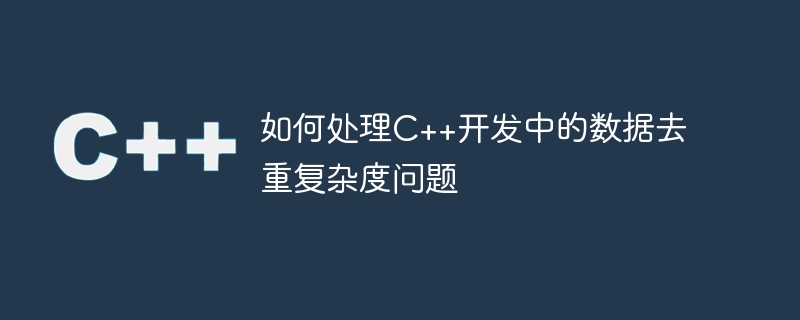Home >Backend Development >C++ >How to deal with the complexity of data deduplication in C++ development
How to deal with the complexity of data deduplication in C++ development
- 王林Original
- 2023-08-22 14:51:331539browse

How to deal with the complexity of data deduplication in C development
In C development, we often encounter problems that require deduplication of data. Data deduplication is a common task, especially when large amounts of data are involved. However, data deduplication often faces complexity problems. This article will introduce some methods to deal with the complexity of data deduplication in C development.
First of all, it is very important to understand the complexity of data deduplication. The complexity of data deduplication usually depends on two factors: the size of the data collection and the uniqueness of the data elements. The larger the data collection, the higher the time and space complexity required for deduplication. The uniqueness of data elements determines the efficiency of the deduplication algorithm. Simply put, the higher the uniqueness of the data elements, the lower the complexity of the deduplication algorithm.
Next, we introduce several commonly used methods to deal with the complexity of data deduplication.
- Hash table method
The hash table method is a commonly used method to solve the problem of data deduplication. It works by mapping each data element with its hash value and storing the mapping results in a hash table. When a new data element needs to be inserted, its hash value is first calculated, and then the hash value is used to find whether the element already exists in the hash table. If it exists, no insertion is performed; if it does not exist, it is inserted into the hash table. This can achieve efficient deduplication operation with a time complexity of O(1).
- Sort method
Sort method is another method to solve the problem of data deduplication. It sorts the data set and then compares adjacent elements for equality. If equal, the next element is deleted. This can achieve data deduplication, and the time complexity is O(nlogn).
- Bitmap method
The bitmap method is a deduplication method suitable for situations where data elements are sparse. It uses a bitmap array to represent the presence or absence of each element in the data collection. Each bit in the bitmap corresponds to a data element. If the bit is 1, it means that the element exists; if the bit is 0, it means that the element does not exist. This can save a lot of storage space, but when the data elements are dense, the effect of the bitmap method is not ideal.
In addition to the methods introduced above, there are many other methods to deal with the complexity of data deduplication, such as using binary trees, hash functions, etc. The selection of an appropriate deduplication method should be determined based on the actual situation, taking into account the size of the data set and the uniqueness of the data elements.
To sum up, dealing with the complexity of data deduplication in C development is a relatively complex task. Depending on the size of the data collection and the uniqueness of the data elements, we can choose an appropriate deduplication method to solve this problem. By using methods such as hash table method, sorting method, bitmap method, etc., we can achieve efficient deduplication operations. However, it should be noted that different methods are suitable for different situations, and choosing the appropriate method is the key to solving complexity problems.
The above is the detailed content of How to deal with the complexity of data deduplication in C++ development. For more information, please follow other related articles on the PHP Chinese website!
Related articles
See more- How to Initialize Private Static Data Members in C Without Static Constructors?
- Is Pointer Arithmetic on Non-Array Data Structures Defined or Undefined Behavior in C ?
- Can C Compilers Optimize Out Heap Memory Allocations Using `new`?
- Why Aren't Function and Data Pointers Always Compatible in C/C ?
- How Can Inner Classes in C Access Private Members of Their Enclosing Class?

